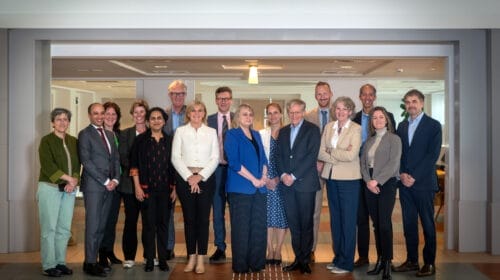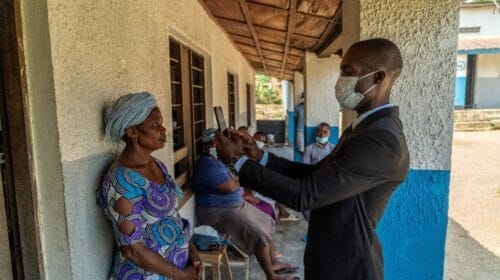We all can work, but together we win: Unite to #EndTB
Despite commitment from the governments to end tuberculosis (TB) by 2030 (one of the targets of Sustainable Development Goals or SDGs) the pace of TB decline casts serious doubts on eliminating TB in the next 14 years.
The latest Global TB Report of the World Health Organization (WHO) has set the alarm bells ringing: not only have annual TB cases and TB deaths increased compared to previous year, but also the pace of TB decline is not steep enough so as to reach the finishing line in the fight against TB by 2030.
‘Business as usual’ will not work. With this intent we spoke to one of the key people in the global fight against TB, who shared important lessons from the past 25 years and suggestions on how we can accelerate the pace of TB decline so as to meet the goals within promised timelines.
Dr Mario Raviglione had contributed to the development of the DOTS strategy in 1994, set up the global drug-resistance surveillance project (1994) and the global TB surveillance and monitoring system (1995), and has also been the Director of the Global TB Programme at the WHO since 2003. Looking back, it is difficult to deny how the efforts to control TB grew manifold in the past two decades. However the finish line is not yet in sight and lot more needs to happen to get to #endTB target by 2030.
Dr Mario Raviglione who is among the top 10 most cited authors in the TB field globally, spoke with CNS (Citizen News Service) on the sidelines of the 47th Union World Conference on Lung Health in Liverpool, UK. This interview is part of CNS Inspire series – featuring people who have decades of experience in health and development, and learning from them what went well and not-so-well and how can these learnings shape the responses for sustainable development over the next decade.
Fight against TB gained momentum in past two decades
The #EndTB is not in sight but we need to acknowledge how an age-old battle against TB galvanized in the past two decades. “Some of the big moments I have seen in the last few years are linked to the innovations that we finally have after decades in the field of TB. For instance the new molecular diagnostics have been the game changers, and I strongly believe these are the starting point for any TB care and control programme. It is not just the efficiency of the machine or the new technology which is no doubt is remarkable but also the spirit of innovation that accompanied it. This innovation led us to a tool that can make the diagnosis within a couple of hours, which provoked reaction – like ‘we believe in microscopy’ or ‘we do not want to adopt new tools’! As this kind of controversy really pushes people up, so they understood eventually and finally we have new tools for the first time in almost a century to quickly diagnose not just TB but also drug-resistant TB. The two new drugs also provoked enthusiasm, although they are currently limited to multi-drug resistant TB only” said Dr Raviglione.
The WHO is also promoting disruptive innovations in field of TB. A disruptive innovation is an innovation that creates a new market and value network and eventually disrupts an existing market and value network, displacing established market leading firms, products and alliances.
The WHO is hoping that disruptive innovations could lead to integrated solutions for future TB diagnostics connected through computers with health centres. Efforts around big data revolution and transforming precision medicine into precision public health give hope. “It is important to find a balance between the need to have a standard approach, because that is what programmes are good at, and personalized approach. We have now the tools that are conducive to that, if countries start implementing what they have to implement,” said Dr Raviglione.
Is TB everyone’s business?
23 years back in 1993, the WHO had declared TB a global emergency. Also it is important to note that evidence is mounting on how TB is integrated to overall health and development indices. Despite this, progress on making TB everyone’s agenda has been, at best, sketchy.
“What we did not manage to do in past many years is to raise the notion of TB as the main infectious disease killer at the level it deserves to be. That means discussing only with ministers of health was a limitation, because, barring a few exceptions, usually they have limited power – they do not control financing, as in most cases that is the decision of the Prime Minister or Minister of Finance. So what we did not succeed in was to elevate TB to that level. And this is sad,” remarked Dr Raviglione. “The civil society, NGOs, academic institutions, the WHO, and others, have not done a good job in pushing TB on the agenda of those who make decisions. This is what has caused the delays sometimes for the slow progress we have seen. Now this is not acceptable anymore because we have new tools.”
Sustainable development agenda cannot ignore TB
“We have been talking for a while to speak about TB in the context of sustainable development agenda in a multifactorial and intersectorial type of way. In particular we are trying to convince the member States to have a special session at the UN General Assembly next year. We at WHO are constantly promoting a Global Ministerial Conference hosted by the Russian Federation during 16-17 November 2017” shared Dr Raviglione.
This Global Ministerial Conference could be a pivotal event as it is not only aiming to engage ministers of health globally but also ministers of other sectors such as finance, justice, prison, among others. “We really want clear plans and pledges by every country, especially high burden counties, at this conference,” hopes Dr Mario Raviglione.
Experiences in Africa determined him to #endTB
Sharing moments that make him proud when he looks back, Dr Raviglione said: “After coming back from Swaziland the decision to switch to infectious diseases like HIV and TB while I was still doing internal medicine and hoping to pursue cardiology, makes me proud. What I saw in Africa changed my career prospective. Diseases of the poor motivated me.”
More than twenty years ago he realized how critically lacking were standards in global TB care and control and so contributed to the development of DOTS strategy in 1994. “DOTS strategy was a simple and elementary package, providing a system to have diagnosis in right way, treatment in right place and monitor progress” said Dr Raviglione.
When DOTS was launched in 1995 there was no reliable data on drug resistance. So he shouldered the responsibility of setting up a drug resistance surveillance system in 1994. He also shares credit for setting up the global TB surveillance and monitoring system in 1995.
Two decades later, these contributions of Dr Raviglione undoubtedly proved to be game-changers and continue to guide the efforts to #endTB even today. “It was important to ensure the balance between simplicity of the system and importance of data being collected,” he said.
Engaging private sector (non-state actor) is a shared challenge for almost every disease control programme. It becomes more acute in countries where private sector is significantly big. “Engaging non-state private sector is crucial, especially in highest TB burden countries, like India or Indonesia, where private sector is rampant. We embarked on that and Dr Mukund Uplekar did a great job in pursuing that line. We have not yet solved it but we understand it much better now,” said Dr Raviglione.
“Another milestone was when we facilitated civil society engagement in the year 2000,” he said. Engaging affected communities is so very central to improving public health outcomes.
“The development of WHO End TB Strategy with very ambitious targets is an important milestone. Although some people say that it is too ambitious and it will never be reached, but we have the technology and the political will in some places to do it. We have to accelerate progress on all fronts to reach a good part of these goals by 2030,” rightly emphasized Dr Raviglione.
Shobha Shukla, Citizen News Service – CNS
- Shared under Creative Commons (CC) Attribution License



